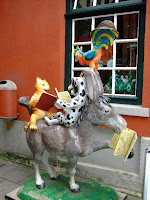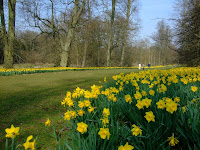Just an hour's flight from London is the picturesque city of Bremen.


The square in the old town is almost entirely bordered by old gabled buildings but the crowning glory is the Rathaus, reportedly saved from destruction (along with the 1404 statue of Roland) in WWII by an Allied bomber who deliberately missed his target.

The Rathaus was built in 15th C but many other 'old' buildings are modern reproductions restored after the destruction of WWII.
One of Bremen's claims to fame is the huge Becks brewery; another is the Bremen Town Musicians made famous by the Brothers Grimm. The 'musicians' are a donkey, a dog, a cat and rooster.

Fearing for their lives they meet up and set off for Bremen to start a new life as musicians but after settling down in a robbers den never actually make it to Bremen. This has not stopped the merchants of Bremen milking the Musicians of Bremen for all they are worth, taking the tourist cash for all manner of copies of the famous, post-war, statue of the Musicians that now stands by the side of the Rathaus.

Bremen is a City State, a self-governing area run by the city merchants rather than the nobility. It has a strong maritime history although the Weser has since silted up preventing the larger ships from reaching the city. A savvy mayor, realized this was going to be a problem so purchased land at the river mouth and created Bremerhaven, now one of the largest container ports in Europe. Although not joined to Bremen it is part of the same City-State and has been the departure point for thousands of Germans setting off for a better life, just like the mythical Musicians.

An interesting feature, just outside our hotel window was the carillon. Its unique claim to fame is that the bells are all made from Meissen china. It is situated in a quaint street built in the 1920s by Ludwig Roselius, the man who invented decaffeinated coffee.

Hitler wanted the street destroyed as it was 'corrupt' art but Ludwig convinced Hitler to preserve it as a good example of a bad example to help prevent others straying from all that was Aryan and pure: and we are fortunate that he did as it is a wonderful example of the brick mason's art.

The oldest area of the town is the area that once was home to the fishermen. Today it is easier to find a pricey fish restaurant than a fisherman, as it is now a twee tourist trap full of boutiques, galleries, restaurants and tourist tat. Many quaint old buildings remain or have been restored making it a pleasant area to stroll around.
The highlight of the trip was the guided tour of the Rathaus, now a UNESCO World Heritage site. The main room is quite amazing with huge roof beams allowing the builders to avoid pillars.


Four huge model galleons hang from the rafters and the, rather

out of scale, canon are used to fire a salute to honour achievements rather than pin medals on the recipient. According to our guide, this act has blown out the windows on occasions when those in charge forgot about the air pressure waves and forgot to open the windows before firing.


















































